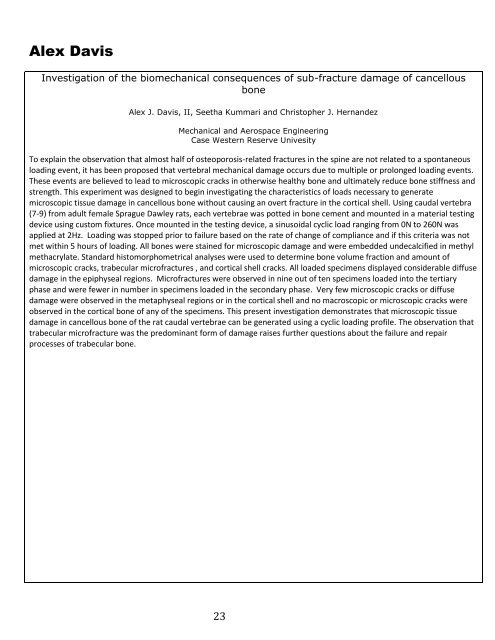student research day - Case Western Reserve University School of ...
student research day - Case Western Reserve University School of ...
student research day - Case Western Reserve University School of ...
Create successful ePaper yourself
Turn your PDF publications into a flip-book with our unique Google optimized e-Paper software.
Alex Davis<br />
Investigation <strong>of</strong> the biomechanical consequences <strong>of</strong> sub-fracture damage <strong>of</strong> cancellous<br />
bone<br />
Alex J. Davis, II, Seetha Kummari and Christopher J. Hernandez<br />
Mechanical and Aerospace Engineering<br />
<strong>Case</strong> <strong>Western</strong> <strong>Reserve</strong> Univesity<br />
To explain the observation that almost half <strong>of</strong> osteoporosis-related fractures in the spine are not related to a spontaneous<br />
loading event, it has been proposed that vertebral mechanical damage occurs due to multiple or prolonged loading events.<br />
These events are believed to lead to microscopic cracks in otherwise healthy bone and ultimately reduce bone stiffness and<br />
strength. This experiment was designed to begin investigating the characteristics <strong>of</strong> loads necessary to generate<br />
microscopic tissue damage in cancellous bone without causing an overt fracture in the cortical shell. Using caudal vertebra<br />
(7-9) from adult female Sprague Dawley rats, each vertebrae was potted in bone cement and mounted in a material testing<br />
device using custom fixtures. Once mounted in the testing device, a sinusoidal cyclic load ranging from 0N to 260N was<br />
applied at 2Hz. Loading was stopped prior to failure based on the rate <strong>of</strong> change <strong>of</strong> compliance and if this criteria was not<br />
met within 5 hours <strong>of</strong> loading. All bones were stained for microscopic damage and were embedded undecalcified in methyl<br />
methacrylate. Standard histomorphometrical analyses were used to determine bone volume fraction and amount <strong>of</strong><br />
microscopic cracks, trabecular micr<strong>of</strong>ractures , and cortical shell cracks. All loaded specimens displayed considerable diffuse<br />
damage in the epiphyseal regions. Micr<strong>of</strong>ractures were observed in nine out <strong>of</strong> ten specimens loaded into the tertiary<br />
phase and were fewer in number in specimens loaded in the secondary phase. Very few microscopic cracks or diffuse<br />
damage were observed in the metaphyseal regions or in the cortical shell and no macroscopic or microscopic cracks were<br />
observed in the cortical bone <strong>of</strong> any <strong>of</strong> the specimens. This present investigation demonstrates that microscopic tissue<br />
damage in cancellous bone <strong>of</strong> the rat caudal vertebrae can be generated using a cyclic loading pr<strong>of</strong>ile. The observation that<br />
trabecular micr<strong>of</strong>racture was the predominant form <strong>of</strong> damage raises further questions about the failure and repair<br />
processes <strong>of</strong> trabecular bone.<br />
23
















